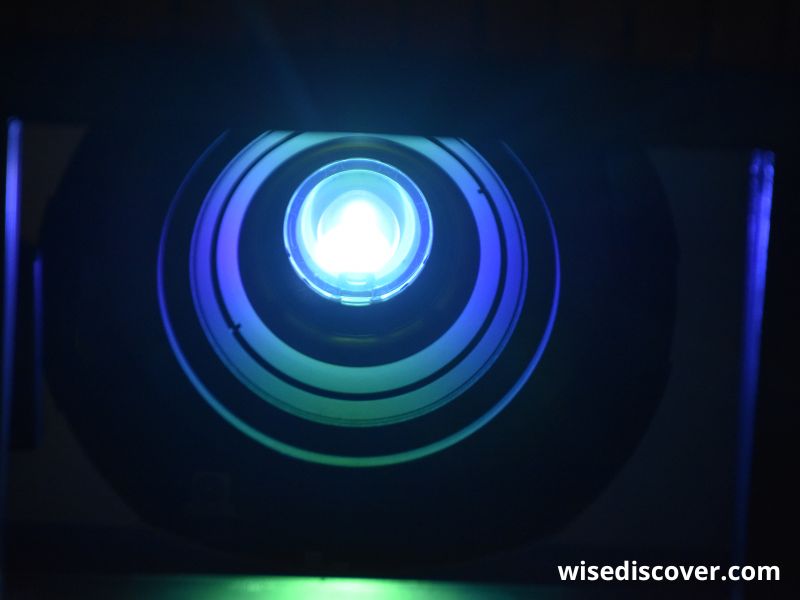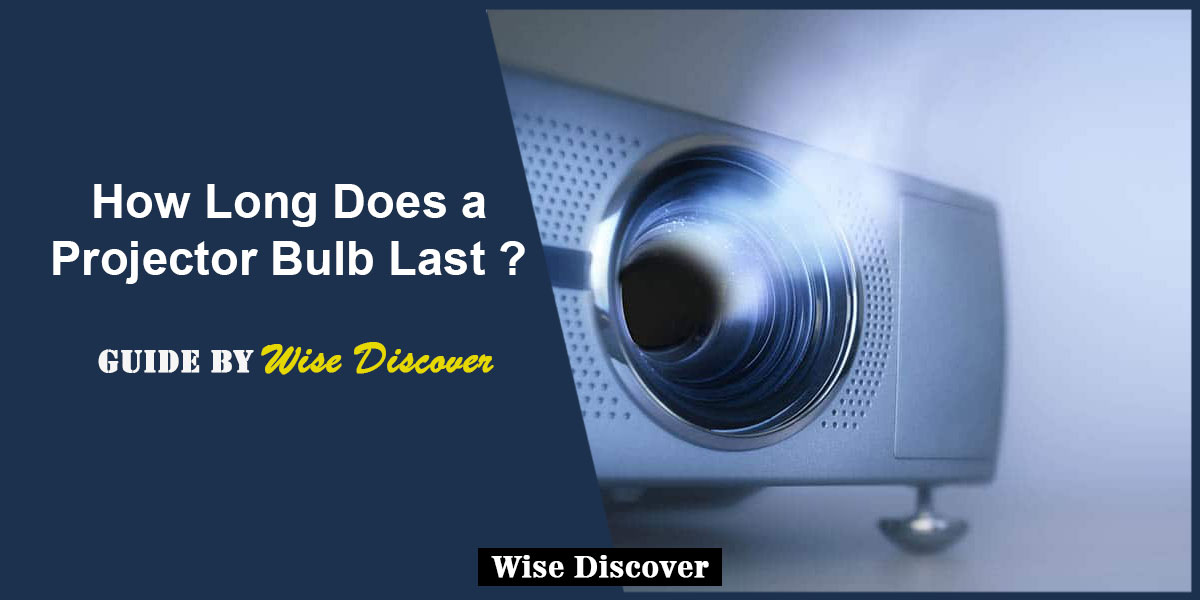Replacing a projector’s lamp can be expensive. The limited lifespan of a projector can have an impact on the ownership, and mishandling can further reduce the lifetime. Being aware of the life expectancy of a projector’s bulb saves you money in the long run. It also helps you make a good choice among the list of projectors you want to purchase. Therefore, the working hours of the projector are on the top of the list of concerns when it comes to owning a projector. It is a common question to ask “how long does a projector bulb last?”. In this article, we have tried to answer, by putting forward all of the information regarding the lifespan of a projector’s bulb and the factors that affect the lifespan of the bulb. But before that, it is important to learn the type of projector lamps and their expected lifespan.
Table of Contents
What is a projector’s lamp life?
Projector lamp life is the extent to which your projector can work. The longer the projector lamp lasts, the longer you would be able to execute every ounce of luminance from the projector. Once the lamp goes out, it needs to be replaced, which can be expensive. Since it is a common concern for the customer, various manufacturers prioritize the projector bulb lifespan while designing their products. The use of advanced technologies had affected the bulb output positively.
Moreover, abuse, dust, overheating, and other factors can reduce the projector’s lamp life. Hence, your projector’s bulb doesn’t need to last, as specified. However, you can enhance this span by taking good care of your projector with proper use and occasional clean-up.
What are specified projector lamp hours
 All projectors offer a specific time limit on the operating hours of the lamp. This is usually mentioned in the manual as “Lamp life” and “warranty”. For most projectors (standard halide or halogen lamps), it ranges from 1,500 to 2,000 hours, while for some modern projectors, it can reach up to about 5,000 endless working hours. LED projectors with advanced technology are said to last up to 60,000 hours, and laser projectors offer about 20,000 hours of life. For continuous use, a projector can last up to 3-7 months. It is when you use a projector 24 hours a day, seven days a week. But using the projector 3-5 hours a day will give you years of use. However, this can be expected only under standard conditions. Multiple reasons, including mishandling and temperature stress, can reduce the lifespan of a projector bulb. Other factors also affect this, including dust, abuse, and accidental drops, causing the bulb to wear out as early as possible.
All projectors offer a specific time limit on the operating hours of the lamp. This is usually mentioned in the manual as “Lamp life” and “warranty”. For most projectors (standard halide or halogen lamps), it ranges from 1,500 to 2,000 hours, while for some modern projectors, it can reach up to about 5,000 endless working hours. LED projectors with advanced technology are said to last up to 60,000 hours, and laser projectors offer about 20,000 hours of life. For continuous use, a projector can last up to 3-7 months. It is when you use a projector 24 hours a day, seven days a week. But using the projector 3-5 hours a day will give you years of use. However, this can be expected only under standard conditions. Multiple reasons, including mishandling and temperature stress, can reduce the lifespan of a projector bulb. Other factors also affect this, including dust, abuse, and accidental drops, causing the bulb to wear out as early as possible.
Unfortunately, under frequent use, projectors are more exposed to factors facilitating the wear. Some projectors stop working instantly, while other dims over time or start flickering. The flickering indicates that it is time for a replacement. You can also check the average lifespan of your projector’s bulb. For this, you need to calculate the average duration of the bulb’s output by subtracting the number of hours of use from the specified average lifespan. A bell curve of the bulb judges this.
Type of projector lamps and expected hours
LED and Metal Halide bulbs are most commonly employed in projectors. The Metal Halide bulbs are more famous owing to their brightness and affordability. They have bulbs with ultra-high-pressure mercury vapors. They offer a maximum lifespan of 2000-3000 hours. In contrast to this, LED projectors last for 60,000 hours. However, they do not provide as much brightness as home theater projectors. The laser projectors with amplified technology come with a lamp life of about 20,000 hours. Modern projectors come as lightweight projector models and are equipped with the latest technology enhancing bulb life.
What is the half-life of a projector?
The half-life of a projector is the duration after which the projector’s brightness reduces to half of its initial brightness. It is about 750 hours for a standard lamp, and for LED lamps it is about 30,000 hours. Several projector bulbs give out when it reaches their maximum lifespan. While others, including mercury and xenon bulbs, dim over time, letting you know when to replace them. Once the brightness of a projector is reduced by 50%, it is recommended to replace the lamp.
How to check projector lamp hour (Checking Lamp Life or Lamp Hours)
To check the lamp hours:
- Go to the system setting or menu and check when you’ve used the projector. You can also physically inspect by taking apart the projector. However, this is not recommended for projectors under warranty. Few projectors also offer indicators of lamp hours via a smartphone app.
- Go for the projector’s manual and look for how the information is displayed. Some projectors have a button or a menu that directs you to the lamp hours of the projector.
- Some projectors, especially the old ones, require you to press the power-off button for a while. If you own an old model, then this might work for you.
When to replace the projector bulb?
With time the projector bulb starts to wear off. It reduces its brightness up to several percent. However, it is not noticeable. Pressure builds inside the bulb, and it starts losing its power. Once the half-life has been met, the brightness reduces up to 50%, and the project bulbs flicker. The temperature stress may also cause the lamp to wear out. Modern projectors come with a lamp counter that lets you know when to replace the bulb. Once the bulb is returned, the counter resets to the initial value. Several bulbs stop working instantly while the projectors with high-pressure mercury and xenon bulbs dim over time. However, if it is not replaced, it can affect the image quality. Therefore, it is better to look for lamp replacement beforehand.
Lamp Replacement Options

In some projectors, replacing the bulb alone helps and is a lot cheaper. However, other lamps require replacing the whole lamp. Since all projectors are built differently, your projector’s manual will help you learn about the projector. Or can contact the customer service as well. Lamp replacements are an effective method over buying another projector instead. One can purchase an original bulb replacement from the manufacturer. However, this can be expensive. You can get a cheaper copy bulb as an alternative, offered by various other companies.
Original equipment manufacturer (OEM) bulb replacement can be purchased. They are the exact replacements and offer a better life cycle. They can be expensive. However, some manufacturers reduce the cost of OEM lamps to encourage their use. Third-party companies also provide other alternatives. They are generally cheaper than OEM. But a downside to them is the non-consistent life expectancy. They can also reduce the projector’s shelf life. Therefore one must be careful while buying the replacement.
Factors that affect the life expectancy of a projector bulb
As discussed earlier, all projectors come with average lamp hours. Multiple factors then contribute to reducing this timespan, causing a likelihood of bulb failure. It is of prime importance to understand the reasons that affect the lifespan of the projector bulb. This helps in adapting ways to avoid the damage. Some of the factors affecting the bulb life of a projector are discussed below:
Overuse:
Projectors offer a life of multiple hours of consistent use. But this doesn’t mean keeping the projector on the run 24 hours a day, seven days a week which is practically impossible. For an average projector, 3-4 hours a day can help you use it a bit longer. Otherwise, expect the bulb to blow out or any other fault for more continuous use. This is because the component wears due to overheating and constant operation. Therefore, using the projector from time to time is recommended rather than all at once.
Overheating:
Continuous usage of a projector can result in more dissipation of heat. Usually, projectors come with built-in fans and a ventilation system to avoid this hassle. However, sometimes the overheating of the projector to an extent where it cannot dissipate the heat can be problematic. This can cause temperature stress to build up, affecting the projector’s other components, including the bulb. Moreover, more careless usage can result in piles of dust and junk over the projector, which can also facilitate overheating. Therefore, it is recommended to clean the projector frequently.
Enough time to cool down:
Projectors need time to cool down. Therefore, leaving the projector for at least 10 minutes after it is powered off is recommended. Once the fan stops running, you are good to go. Following this is helpful; otherwise, the temperature stress can cause the projector to be more susceptible to damage.
Dust in vents and Air filters:
Like all other devices, including PCs and Laptops, the projectors include exhaust and air filters to prevent overheating. The dust clogged in the air ducts can result in overheating. It also can cause damage to the circuits. Therefore, it is recommended to clean the projector every once a month. If not possible, you can try the cleaning procedure once every 3-4 months. This will ensure long-lasting life for your projector and bulb, of course.
Clean and airy environment:
Airflow in the circuitry prevents overheating. Therefore, it is essential to keep the projector clean and airy. There should be no contaminants blocking the vent. Before mounting the projector, the area should be cleaned to prevent debris. Using a projector in open areas will improve airflow. Moreover, if you use the projector in spaces that are likely to get dusty, you should clean it often. Let your projector breathe in quality air.
Economy mood:
Various projectors come with an economy or safe mood. It decreases the projector brightness to reduce overheating risk, ensuring a long-lasting lamp. This extends the lamp life of the projector up to multiple folds.
Handling with care:
The lamp life may vary depending on the abuse, accidental drops, etc. Accidental drops can cause damage to the projector bulb. It can either reduce the shelf life or damage the bulb entirely. So, handling the bulb and projector with care is essential. Sometimes, while replacing the bulb, you can damage it, causing it to overheat. Therefore, to avoid premature damage, it is better to handle it with care. You get a free replacement if the projector fails to meet the specified time. However, the condition must not be damaged by the user itself.
So how long does a projector bulb last
How long a projector bulb last solely depends on the type of lamp and the use. For an average projector used 3-5 hours a day, 1000-2000 hours can be expected several times a week. Led offers 30 years, laser ten years, and metal halide up to 2.5 years of everyday use. However, more frequent use can result in a quicker replacement. For some users replacing a bulb every once or twice a year won’t be a problem.
In contrast, other users wouldn’t like this very much. If you try to prevent the heat damage, clean it often, and enhance life span can be expected. If you are more concerned about the shelf life of the projector, then an energy saver projector would be a good choice. The central theme of enhancing the projector bulb’s life expectancy is handling it with good care.
